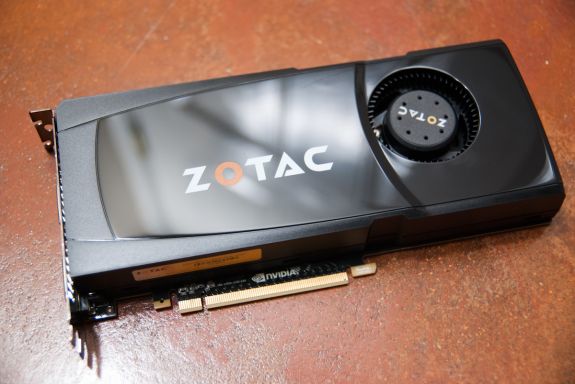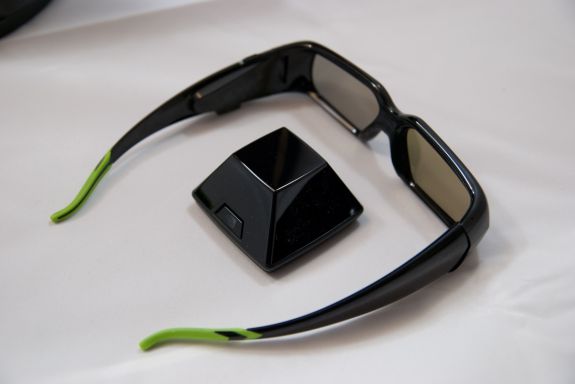ASUS VG236H 23-inch 3D Display Review: 120Hz is the Future
by Brian Klug on August 7, 2010 2:48 AM EST3D Vision on the VG236H
So let’s talk about 3D for a bit before going into the deep bits of the display’s performance. We’ve already covered NVIDIA’s 3D Vision here, but this review would just be incomplete without discussing how much I’ve changed my mind about 3D after playing with the VG236H.
First off, the NVIDIA 3D Vision kit itself is unchanged, though the packaging is a bit more compact. Inside is a soft cloth bag for the classes, two different nasal guides for comfort, two different length USB cables, the IR base station pyramid, shutter glasses, and demo and driver CDs. It feels like a high end product, with the base station pyramid and glasses sitting in foam cutouts, and the requisite accessories in a compartment above.
Additionally, you’ll need a 3D Vision compatible GPU, and can only drive 120Hz refresh rates over DVI-D, not HDMI. Because you’re rendering twice the frames (one for each eye), you’ll take a framerate hit for enabling 3D, so that GPU best be powerful. Zotac graciously supplied their ZOTAC GeForce GTX 470 for testing, which worked perfectly in my testbench.
I noted before that I’ve been skeptical about mainstream 3D gaming for some time now. I’ve seen my fair share of 3D content - though not as much as most of the other AnandTech writers that experienced it at CES on myriad displays - but have an above average grasp for the tech thanks to my optical sciences background.
That out of the way, most of the shutter or polarization based methods I’ve seen up until now suffered from being flickery. Refresh rate just wasn’t high enough, and the result was that I could detect individual frames when moving my head or really looking for it. In theaters, I tried the circularly polarized passive RealD system, and another IMAX 3D system using linear polarization. I had also tried a number of active LCD shutter systems on LCD TVs. While impressive, all of them had noticeable flicker.
The VG236H is the first 3D implementation I’ve played with that doesn’t have noticeable flicker. It just doesn’t. I was immediately impressed with the NVIDIA 3D Vision setup.
NVIDIA thankfully has a pretty comprehensive list of 3D Vision games and how good they perform with the whole system. At the top of the scale is 3D Vision Ready, meaning the game has basically been developed from the start to be viewed in 3D or 2D. Down the list is excellent, good, fair, poor, and not recommended. I first tried a number of ‘good’ titles, and found that while the 3D experience indeed worked, but often small things got in the way.













121 Comments
View All Comments
ganeshts - Saturday, August 7, 2010 - link
True, but the fact of life is that more monitors support HDMI compared to DisplayPort.Also, most upcoming GPUs claim HDMI 1.4a support, but DisplayPort 1.2 is not seen (that is necessary for 3D).
All 3D TVs use HDMI 1.4. So, if there is one interface to do the job for both TV and monitor, I will gladly take it :)
Pozz - Saturday, August 7, 2010 - link
Most Importantly, why component instead of vga/another hdmi input? mehmbtgood - Tuesday, August 24, 2010 - link
i like mbt alotwww.mbt-usa.com
BladeVenom - Saturday, August 7, 2010 - link
As much as that monitor is going to cost, it's just not worth it when they skimp on the connections.I'm not going to buy another monitor without Displayport.
DarkUltra - Sunday, August 8, 2010 - link
Me too. DisplayPort is needed if we want 120hz in anything higher than 1920x1200. Dual-link dvi maxes out at 1310p @ 120hz I think. 2560x1600x120x24 = 11.8Gbps and displayport can do 17.28Gbps. Fonts look real nice in 135dpi.medi01 - Saturday, August 7, 2010 - link
I rather wish I could buy new 4:3 monitor...softdrinkviking - Sunday, August 8, 2010 - link
http://www.eizo.com/global/products/flexscan/index...you can
mino - Tuesday, August 10, 2010 - link
Check the price ... not everybody who need a screen for work is a DTP/CAD/media professional.softdrinkviking - Saturday, October 23, 2010 - link
true. it's pricey, but they look fantastic and it won't need replacing for a good, long time.when you want an older tech that has become a specialty item, you have to expect it to be more expensive, that's life.
mino - Tuesday, August 10, 2010 - link
Yeah, tell me about it.Needed 1600x1200 (even 1600x1600 would be welcome) had to go for 1920 and got luxky a reasonable 1920x1080 are still made ...
Most is just 16:9 useless junk.